The relations between Ukraine's two biggest Orthodox churches, the church of the Moscow Patriarchate (UOC MP) and the church of the Kyiv Patriarchate (UOC KP), were always complicated. But since the start of the war in Donbas the UOC MP, the preferred church of the Yanukovych regime, has come into real trouble. But although the UOC KP supported the Euromaidan Revolution and the Ukrainian Army in the East, the MP remains the biggest church in Ukraine and a force to reckon with. Chris Linderhof explores the backgrounds.
by Chris Linderhof
This essay looks at the relations between Ukraine's two biggest Orthodox churches, the Ukrainian Orthodox Church of the Moscow Patriarchate (UOC MP) and the Ukrainian Orthodox Church of the Kyiv Patriarchate (UOC KP).
Since the start of the war in Donbas the UOC MP has come into trouble. The UOC MP was the preferred church of the Yanukovych regime and is big in almost the whole country. The variety of opinions within the church, but also the messages emanating from the 'Motherchurch' in Moscow, make it vulnerable.
The UOC KP has stricken a different tone right from the start, supported the Euromaidan Revolution in 2014 and the Ukrainian Army in the East gaining in stature and parishioners, but so far the number of defections of parishes and parishioners form the MP to the KP seems rather restricted. In 2018, the MP remains the biggest church in Ukraine and a force to reckon with.
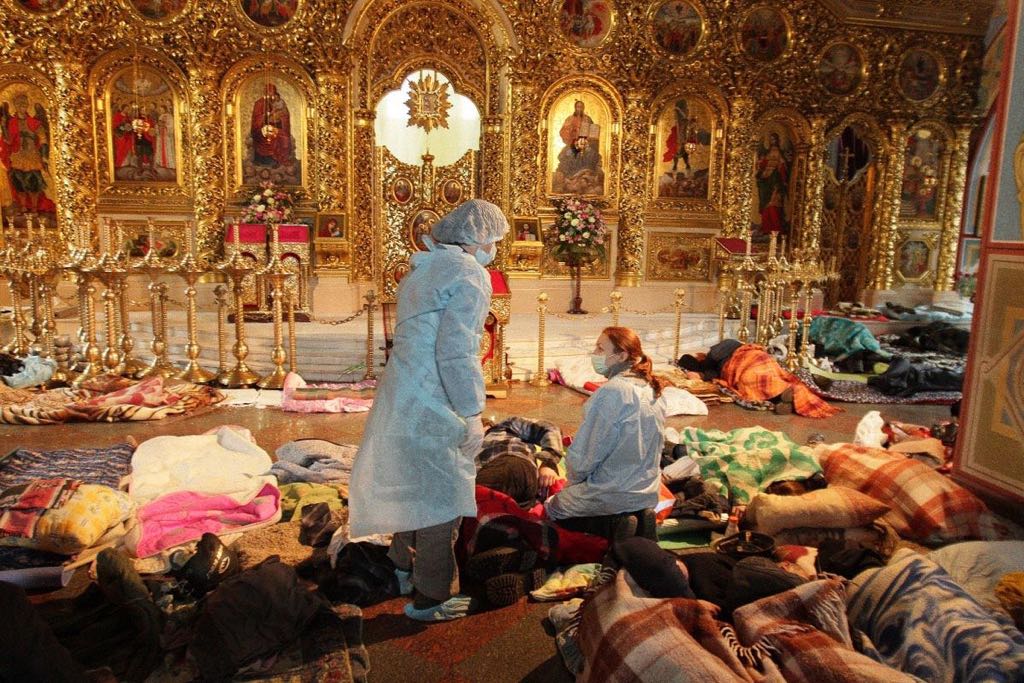
Mikhajlivskyj Monastery, giving shelter to protesters during the Euromaidan.
Ukrainian independence and the origins of the Church conflict
Ukraine has four main nationally recognized Orthodox Churches: the UOC MP, the UOC KP, the Ukrainian Autocephalous Orthodox Church (UAOC) and the Ukrainian Greek Catholic Church (UGCC). Conflicts exist between all these churches, but due to a lack of space I will focus on the conflict between the two biggest ones: the MP and the KP.
In 1991 Ukraine gained independence. The political establishment of the new state soon realized that an independent state also needed an independent church. Its most logical basis would be the Russian Orthodox Church (ROC), which was the only allowed Orthodox Church during the last decades of Soviet rule and over half of its 7000 parishes were located in Ukraine, mostly in the Western, former 'Uniate' territories.1 2 3
In 1990, after the death of Partriach Pimen of the ROC, Metropolitan Filaret, his right hand, was expected to become the new Patriarch. The vote turned out differently though. His bishops rebelled against him and in May 1992 Filaret was deposed.4 He then created his own church: the UOC KP. Since 1995, after another merger and split there exist four main Orthodox churches in Ukraine. The relations between them have been tense, because all churches accuse each other of 'stealing' whole Church buildings, parishes and even bishops.
Canonicity
One of the main factors in the current conflict is canonicity, the principle that the church is established according to the Orthodox canons, and is recognized as such by the other mostly national Orthodox Churches. The only church that receives international recognition as Orthodox Church in Ukraine is the Moscow Patriarchate (UOC MP), which is, as said, still subordinate to the Moscow Patriarch.
The UOC KP has sought official recognition for its Autocephaly from their establishment in 1992 and often had the government on its side. Since Moscow categorically does not want to grant Autocephaly to any Ukrainian Church, the only way to gain it was to request it from the Ecumenical Patriarchate in Constantinople, which sees itself as the Motherchurch of all Orthodox Churches. Ukrainian Presidents Leonid Kravchuk (1991-1994) and Viktor Yushchenko (2005-2010) both asked Ecumenical Patriarch Bartholomeus to grant canonical status to the Kyiv Patriarchate.5
Especially the celebration of 1020th anniversary of the Baptism of Rus' in 2008 was a chance for Yushchenko to gain this Autocephaly from Constantinople, but the attempt failed allegedly due to the insistence of Filaret (KP) that only he could be the Patriarch of a united Church.6 The Ecumenical Patriarch has consequently stated that first the Ukrainian Orthodox Churches should unite amongst themselves and only then the issue of canonicity can be fully addressed.
It must be said that the Moscow Patriarchate uses its own canonicity as its major trump-card7, depicting the other Orthodox Churches as heretics who should show repentance and return to the fold of the (Moscow) Motherchurch. The fact that it obtained this canonicity by bribing the Patriarch of Constantinople in 1686 is conveniently ignored.8
Personalities of Filaret and Onufriy
Also of importance in the standoff between the Orthodox Churches are the personalities of the leaders of the MP and KP, Metropolitan Onufriy and Patriarch Filaret respectively.
Onufriy is born in the Western province of Bukovyna and was known for his staunch pro-Russian positions which he demonstrated in the Kharkiv Sobor in 1992 when the now Patriarch of the KP Filaret tried to obtain Autocephaly and Onufriy voted against. He became the locum tenens of the MP in February 2014 because of the ailing health of Metropolitan Volodymyr and had by then already turned to pro-Ukrainian positions.9
Filaret, on the other hand, is born in Eastern Ukraine, in Donetsk oblast. He was the exarch of the ROC in different countries in the sixties, seventies and eighties10 and in 1990 the main pretender to take Patriarch Pimen's place. After this failed, Filaret, who had all his life supported the Russification of the ROC in Ukraine, made a U-turn to pro-Ukrainian positions11 and established his own church, the UOC KP.
Since Onufriy is one of the bishops who prevented Filaret from becoming the all-Russian Patriarch, it is clear that there is enmity between the two leaders. This is an extra complicating factor in the process of unification of the churches.
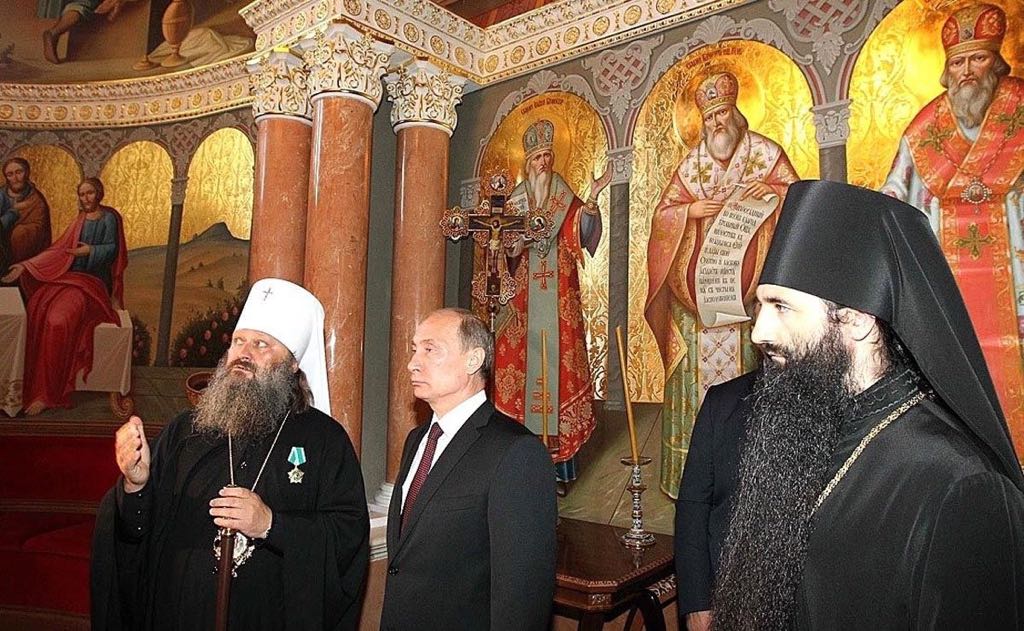
President Putin visiting the Pecherskyi Monastery, before the Maidan.
Stances of the KP and MP on the annexation of Crimea and the war in Donbas
With the Euromaidan in November 2013 a new period of political turmoil started in Ukraine, which after the Russian intervention in Crimea in Spring 2014 even turned into a war.
The KP, with its more nationally oriented leadership and parishioners immediately took the side of the protesters in November 2013, opening even the Mikhaylivskyi monastery as a makeshift hospital.12
The MP found itself in an awkward position. It had openly supported Ukrainian president Yanukovych (2010-2014) in the preceding years and had benefited from that. During the Euromaidan the MP did not officially take sides though several MP clerics appeared on Maidan, calling mostly for a peaceful solution (Denysenko: 252). On the other hand other MP clerics harshly criticized Euromaidan and even a 'crusade' (хресна хода) against it was organized.13
After Yanukovych had fled the MP denounced him and held him responsible for the crisis in Ukraine (Denysenko: 253). When Russia invaded Crimea, the MP did formally respond. Metropolitan Onufriy wrote a letter to Patriarch Kirill asking him to persuade Putin to withdraw his troops. In his response Kirill assured that ‘the Ukrainian people must determine their own future without external influence’ (Denysenko 253).
At the same time Kirill refrained from attending the annexation ceremony of Crimea by Putin's Russia in March 2014 (Mitrokhin 2014) and up to date Crimea is still not accepted as canonical territory by the ROC, leaving it in the jurisdiction to the UOC MP.
The silence of Kirill leaves room for other, far more outspoken propagators of the 'Russkiy mir', such as Vsevolod Chaplin, in 2014 spokesperson of the ROC, who even managed to call the invaders 'peacemakers' (Denysenko: 252). The obvious support for the invasion among the ranks of the ROC made the situation for the UOC MP even more peculiar. Being considered 'traitors' by large parts of the Ukrainian population, many MP clerics actually held pro-Ukrainian positions themselves (Mitrokhin 2014). Since then, Onufriy and the UOC MP are continuously performing a balancing act between the pro-Ukrainian and pro-Russian factions within their own church, with a fair amount of parishes located in areas that are now occupied. The MP is collecting money and materials for displaced people and has also recently started to prepare chaplains for the Ukrainian Army,14 although the KP and Ukrainian nationalists claim that it would be detrimental to national security to allow MP chaplains into the barracks.15
Is the Moscow Patriarchate losing ground in Ukraine?
There are several ways to answer this question. Since there are no statistics on the numbers of parishioners attending masses, we will look at which church Ukrainians prefer and also at the numbers of parishes each Patriarchate. I chose to use the 2017 inquiry on Ukrainians' religious views conducted by Razumkov Center, since this is one of the most respected analytical centers in Ukraine and their research covered a broad range of questions concerning religious life.16
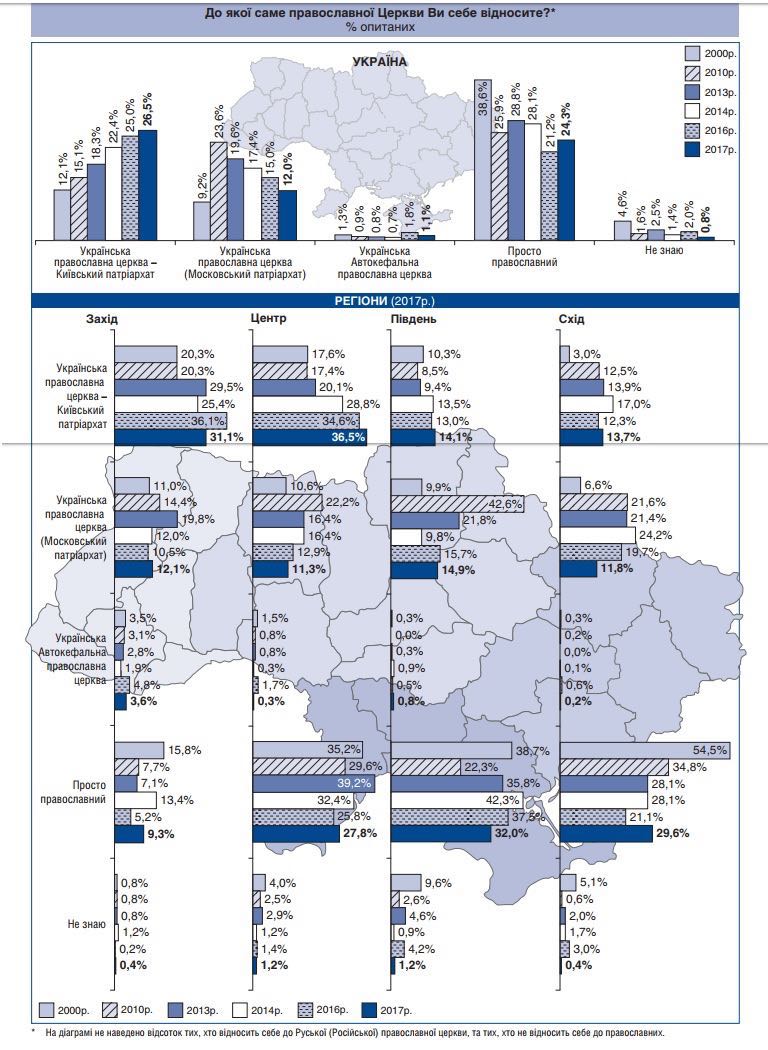 |
picture 1
On the question ‘To which Orthodox Church do you belong?’ picture 1 shows that the KP turned out to be the biggest Orthodox Church in 2017, gaining 26,5% of the total allegiance, with the MP collecting a meager 12%. There is a clear trend with rising support for the KP and falling support for the MP, visible already before the war, but it seems the war has speeded up this process. The number of parishioners of the UAOC has been stable at around 1%,17 while the percentage of people not declaring themselves members of any denomination fluctuates between 39 and 21%.
Regionally, the developments are also interesting: while in the Western macro-region the number of adherents of the KP has not changed significantly (from 29 to 31%, but with a peak of 36% in 2016), in the Central region the number of KP adherents almost doubled from 20 to 36,5% (and more than doubled if you take into consideration the situation before the war, when the KP gathered 17% adherence). In the South and East a more stable picture arises, with the KP roughly constant at 13/14% in the South and even losing a bit in the East in 2017 compared to 2014 (14 vs 17%).
The Moscow Patriarchate is losing nominal adherence in all four macro-regions. In the West they go from almost 20% in 2014 to 12% in 2017, which is still pretty solid if you consider that in Galicia the MP is virtually non-existent,18 and a higher percentage than in the Center and East(!). In the Center, South and East the MP also declines in the 2014-17 period: from 16 to 11%, 22 to 15% and 21 to 12% respectively.
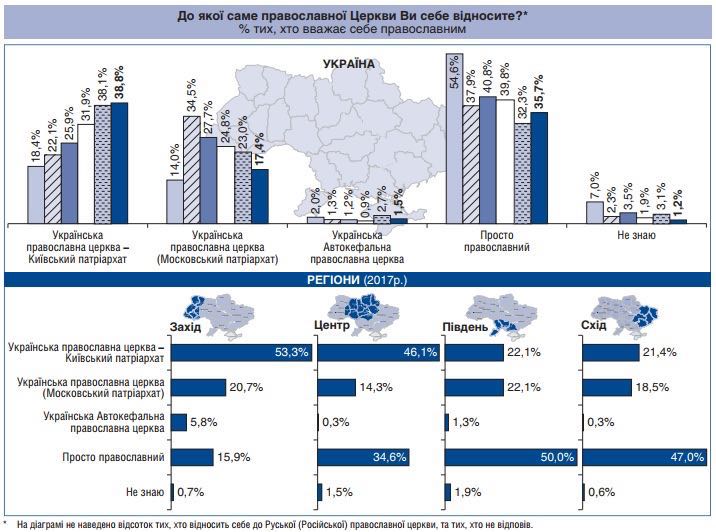 |
picture 2
All in all, it's important to note that the number of persons not denoting affiliation with any of the Orthodox Churches remains very high with still 24% in 2017 in Ukraine overall and 32% in the South, where it is higher than the KP and MP combined. This could mean that a lot of parishioners simply do not know to which Patriarchate the Church they attend belongs to, that they prefer not get involved in Church politics in any way, or that parishioners who disattach themselves from the MP do not automatically go over to another denomination.
The figures for Church allegiance taking into account only those who declared themselves Orthodox in picture 2 confirm the results found above. The KP clearly outpaces the MP in the West and Center and has overhauled the MP in the South and East, but the high percentage of undecided “Simply Orthodox” makes these figures relatively unreliable.
Apart from statistics on Church allegiance, we should also look at the numbers of parishes, churches, monasteries etc. Here the Moscow Patriarchate still vastly outperforms the Kyiv Patriarchate. According to statistics of the MP itself19 the number of parishes in 2017 grew from 12017 to 12069. The Kyiv Patriarchate did not release any statistical information about 2017 yet, but according to the State Committee on Religious Affairs it had 5114 registered parishes at the start of 2017, of which 4790 were active.20 Therefore, we can conclude that the Moscow Patriarchate is still by far the biggest Orthodox Church in number of parishes, while the war did indeed effect the image of the MP in general.
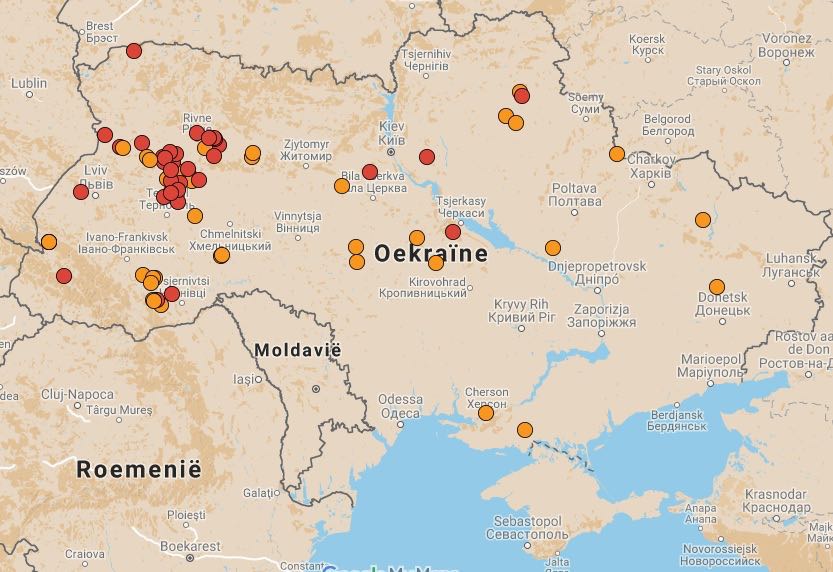
Picture 3
How does this play out on the ground? There has been a flow of MP parishes defecting to the KP, of which the Religious Information Service of Ukraine (RISU) devised a convenient map21, complete with information on each case (picture 3). The orange dots depict parishes that fully switched their allegiance from the MP to the KP, while the red dots indicate parishes where conflicts arose, usually because the parish split into two and one of the two denominations did not want to allow the other one into the Church building any more. The MP accuses the KP of holding 'illegal referendums', while the KP accuses the MP of not handing over the church buildings to the parishes which have switched allegiance to the KP.22 What strikes most is that 'the Church front' is mostly confined to Western Ukraine, more precisely to what used to be Southern Volhynia, modern day north Ternopil oblast and south Rivne oblast.
There is a second, much smaller, 'front' on the border of Galicia and Bukovyna, that is of modern day Ivano-Frankivsk and Chernivtsi oblasts. What makes it painful for Metropolitan Onufriy though is that allegedly his native village Korytne is among the parishes where a conflict about whether to go over to the KP is going on.23
By contrast, in the East and South the number of switches has remained very low, with only two cases in each macro-region. In one village in Kherson oblast the parish switched allegiance after ten villagers joined the Ukrainian Army to fight in Donbas.24 Both in the East and South the switches were not accompanied by conflicts. In the Center, finally, only Cherkasy oblast stands out with five defections.
As causes for switching allegiance the parishioners mostly mention the war instigated by Russia, the fact that the highly unpopular Patriarch Kirill is often still celebrated in masses and sometimes the fact that the priest refused to participate in funerals of fallen Ukrainian soldiers. In a few cases high prices for rituals such as funerals or drunkenness of the priests caused the parishioners to search for a different Patriarchate.
Whether or not the MP can contain the flow of parishes exiting the church remains to be seen. The bulk of the switches occurred in 2014 and 2015 though, therefore the situation seems to have stabilized more or less already. The aforementioned Razumkov statistics showing a small increase in the number of parishioners of the MP in the Western provinces, from 10,5% in 2016 to 12,1% in 2017, also hint in that direction.
The main threats for the MP nowadays are probably the patriotic though oligarchic media and the radical nationalistic organizations. In the media there is regular coverage of the misdoings of the MP, for instance of their love of fancy cars and expensive watches, but also on how several MP clerics support the separatists, do not want to condemn the Russian aggression or even take up arms against Ukraine themselves, etc. Some of these media even give 'advice' on how to fight the MP (by using financial means).25 The radical nationalists take more decisive action, sometimes blocking the Pecherska Lavra26, and most probably also breaking into church buildings, stealing the money collected, destroying church inventory and occasionally committing even arson.27
The MP is not only with the KP in conflict over parishes, but also with for instance the UGCC over several churches,28 but the number of conflicts with the other denominations is far smaller.
Conclusions
Since the start of the Euromaidan Revolution and the following war with Russia the old 'Church wars' of the 1990's have gained new momentum. In the 1990's the conflict took place between all denominations, nowadays it is mainly between the MP and the other Orthodox confessions, especially the KP. Although sociological inquiries suggest that the MP is losing support and that the KP has more support in all four macro-regions of Ukraine, the situation on the ground with the number of parishes suggests something else. The number of parishes of the MP still more than doubles the number of KP parishes. It is of course questionable in how far all these parishes are actually active and to what extent they show real allegiance to their respective Patriarchates, but the fact that most of the 70 defections took place in a relatively small area in Southern Volhynia points out that the positions of the MP are still quite strong, even in Western Ukraine. The leadership of the MP will continue to balance between the different factions within the church itself and between the positions of the Motherchurch in Moscow and nationally Ukrainian oriented parishes. If the MP manages to hold this balance the church will remain a religious and political force to reckon with.
Chris Linderhof studied Slavonic Studies, Greek Language and Culture and Translation Studies at the University of Amsterdam and is currently following a Master in Eastern European History.
Notes
1 Dennis Soltys Shifting civilizational borders in orange Ukraine, p. 164
2 The 'Uniate' Church emerged in the 16th Century in the Eastern lands of the Polish empire in an attempt of the Poles to disattach the local mostly Ukrainian population from the Orthodox Church governed from Moscow and thereby to prevent them from revolting against Polish rule. The Uniates retained their Orthodox rite, but accept the juridical authority of the Pope in Rome. Nowadays the Uniates are mostly referred to as Greek Catholics (UGCC) and comprise one of the four major Orthodox Churches in Ukraine.
3 The reason Orthodox Churches were allowed to operate in the borderlands was that they had become a convenient tool for surveillance on the local population. See for instance Soltys, p. 164
4 Vladimir Ruban 'Moscow wants to subdue Ukraine through the church'
5 Nikolai Mitrokhin Aspects of the religious situation in Ukraine, p. 193 (2001) &
Nikolai Mitrokhin Orthodoxy in Ukrainian Political Life, p. 240 (2010)
6 Nicholas E. Denysenko Chaos in Ukraine, the churches and the search for leadership, p.244
7 For a Russian view on the issue of canonicality see Anastasia Chibisova, The ≪Ukrainian question≫ in the relations between Constantinople and Moscow at the beginning of the 21st century
8 Serhiy Bashinskiy Orthodox Church in Ukraine on a way to Autocephaly: a historical sketch, p. 4/15
9 Nikolai Mitrokhin Cerkovnyi neprichod https://graniru.org/opinion/mitrokhin/m.226918.html, Accesed 4 January 2018
10 Filaret's official biography on the UOC KP website: https://www.cerkva.info/pages/biography, Accesed 2 January 2018
11 A similar U-turn to pro-Ukrainian positions was made by Leonid Kravchuk, who was as head of the agitprop in the Ukrainian SSR involved in the fight against all elements that could be a potential threat to the communist regime, to become the first president of independent Ukraine.
12 Roman Lebed' Jak pid čas majdanu monastyr stav likarneju http://www.bbc.com/ukrainian/blogs/2015/02/150216_maidan_hospital_blog_rl, Accessed 16 December 2017
13 Olha Nedavnja Cerkovno-relihijnyj faktor Euromajdanu v ocinkach joho učasnykiv ta prychylnykiv (ne zakinčennja) https://risu.org.ua/ua/index/studios/studies_of_religions/55245/, Accessed 24 December 2017
14 Zvit kerujučoho spravami ukrajinskoji pravoslavnoji cerkvi za 2017 rik http://news.church.ua/2017/12/27/zvit-keruyuchogo-spravami-ukrajinskoji-pravoslavnoji-cerkvi-za-2017-rik/#more-179493, Accessed 27 December 2017
15 Tetyana Derkach “Nedopuščennja svjaschennykiv UPC (MP) u vijs'kovi častyny – ne dyskryminacija, a pytannja nacional'noji bezpeky”, – Mytropolyt UPC KP Ioan (Yaremenko) https://risu.org.ua/ua/index/expert_thought/interview/66210/, Accessed 10 January 2018
16 For the whole inquiry, see http://razumkov.org.ua/uploads/article/2017_Religiya.pdf, Accessed 28 December 2017. Razumkov is as far is I can judge not linked to any of the current coalition or opposition members, but in the past it was headed by Anatoliy Hrytsenko, who also served as Defense Minister under President Yuschenko. Among the members of Razumkov Centre we do find Minister of Sports Ihor Zhdanov, oligarch Viktor Pinchuk and former MP charged with corruption Mykola Martynenko. http://razumkov.org.ua/pro-nas/kerivni-orhany, Accessed 9 January 2018
17 The Greek Catholic Church (UGCC) is not included in the statistics since it not seen as an Orthodox Church by Razumkov.
18 This is among other things a result of the 'Church wars' of the early 1990s.
19 Zvit kerujučoho spravami ukrajinskoji pravoslavnoji cerkvi za 2017 rik http://news.church.ua/2017/12/27/zvit-keruyuchogo-spravami-ukrajinskoji-pravoslavnoji-cerkvi-za-2017-rik/#more-179493, Accessed 29 December 2017
20 Religious organizations in Ukraine (as of January 1st, 2017) https://risu.org.ua/ua/index/resourses/statistics/ukr2017/67269/, Accessed 29 December 2017
21 https://www.google.com/maps/d/viewer?mid=1OWm7mMk2OG6_-Zb9mYx3nAlrbdQ&ll=49.19337644534723%2C30.33944264999991&z=6, Accessed 4 January 2018
22 There was even at least one incidence in which the KP accused the MP of using 'titushki's' (groups of violent petty criminals) to capture a church building in Pylypets, Zakarpattya oblast. http://zakarpattya.net.ua/News/145643-U-Pylyptsi-na-Mizhhirshchyni-UPTS-MP-syloiu-zakhopliuie-tserkvu-hromada-iakoi-pereishla-do-UPTS-KP, Accessed 12 January 2018
23 https://www.google.com/maps/d/viewer?mid=1OWm7mMk2OG6_-Zb9mYx3nAlrbdQ&ll=48.33093670000004%2C25.382414400000016&z=8, Accesed 12 January 2018
24 https://www.google.com/maps/d/viewer?mid=1OWm7mMk2OG6_-Zb9mYx3nAlrbdQ&ll=46.64768699999996%2C32.60161219999998&z=8, Accessed 12 January 2018
25 24 Channel (linked to Lviv mayor Andriy Sadovyj) https://www.youtube.com/watch?v=CW_ZffYKvvc, Accessed 12 January 2018
26 One of Ukraine's most sacred sites which ended up being the Headquarters of the MP after unclear manipulations by the government.
27 Especially Odesa oblast seems to be a hotbed of these radical actions, despite there being or maybe because of there being no switches from the MP to KP. http://news.church.ua/2017/12/27/zvit-keruyuchogo-spravami-ukrajinskoji-pravoslavnoji-cerkvi-za-2017-rik/#more-179493, Accessed 14 January 2018
28 For instance over a church in Kolomyja (Ivano-Frankivsk oblast) that was administered by the MP, but has now been 'occupied' by the UGCC. https://risu.org.ua/ua/index/all_news/community/land_and_property_problems/68495/, Accessed 15 January 2018
References
Bashynskiy Serhiy Viktorovych, “Orthodox Church in Ukraine on a way to autocephaly: a historical sketch”. Studia Humanitatis, (01 July 2015, Vol.2)
Chibisova, Anastasia, “The ≪Ukrainian question≫ in the relations between Constantinople and Moscow at the beginning of the 21st century” Vestnik Pravoslavnogo Svâto-Tihonovskogo Gumanitarnogo Universiteta. Seria I: Bogoslovie, (01 October 2014, Vol.55(5), pp.9-25)
Denysenko, Nicholas E. “Chaos in Ukraine: the churches and the search for leadership” International journal for the Study of the Christian Church, (10 June 2014, p.1-18)
Mitrokhin, Nikolai, “Aspects of the Religious Situation in Ukraine” Religion, State and Society, (01 September 2001, Vol.29(3), p.173-196)
Mitrokhin, Nikolai, “Orthodoxy in Ukrainian Political Life 2004–2009” Religion, State and Society, (01 September 2010, Vol.38(3), p.229-251)
Ruban, Vladimir, “'Moscow wants to subdue Ukraine through the Church.' (Russian Orthodox Church) (includes short biographical sketch)” Moscow News, (July 19, 1992, Vol.29(3536), p.14(1))
Soltys, Dennis, “Shifting civilizational borders in orange Ukraine: Dilemmas and opportunities for western diplomacy” International Journal, (Winter 2005/2006, Vol.61(1), pp.161-178)
Wasyliw, Zenon V., “Orthodox Church division in newly independent Ukraine, 1991-1995” East European Quarterly, (Fall, 2007, Vol.41(3), p.305(18))
Internet sources
24 Channel (linked to Lviv mayor Andriy Sadovyj), (12 January 2018).
https://www.youtube.com/watch?v=CW_ZffYKvvc
Department concerning affairs of religion and nationalities Religious organizations in Ukraine (as of January 1st 2017), (29 March 2017) https://risu.org.ua/ua/index/resourses/statistics/ukr2017/67269/
Derkach, Tetyana “Nedopuščennja svjaščennykiv UPC (MP) u vijs'kovi častyny – ne dyskryminacija, a pytannja nacional'noji bezpeky”, – Mytropolyt UPC KP Ioan (Yaremenko), (28 February 2017)
https://risu.org.ua/ua/index/expert_thought/interview/66210/
Filaret's official biography on the UOC KP website:
ttps://www.cerkva.info/pages/biography
Lebed', Roman Jak pid čas majdanu monastyr stav likarneju, (18 February 2015
http://www.bbc.com/ukrainian/blogs/2015/02/150216_maidan_hospital_blog_rl
Mitrokhin, Nikolai, “Cerkovnyi neprichod” essay on graniru.org, (19 March 2014)
https://graniru.org/opinion/mitrokhin/m.226918.html
Nedavnja, Olha Cerkovno-relihijnyj faktor Euromajdanu v ocinkach joho učasnykiv ta prykhylnykiv (ne akinčennja), (7 February 2014):
https://risu.org.ua/ua/index/studios/studies_of_religions/55245/
Razumkov inquiry on religious affairs, (24 May 2017):
http://razumkov.org.ua/uploads/article/2017_Religiya.pdf
Razumkov officials
http://razumkov.org.ua/pro-nas/kerivni-orhany
RISU Apeljaciynyj sud stav na bik cerkvi UPC (MP) u Kolomyji, vidmynyvšy rišennja policij(5 October 2017)
https://risu.org.ua/ua/index/all_news/community/land_and_property_problems/68495/
RISU map of parishes changing allegiance from the MP to the KP (updated regularly):
https://www.google.com/maps/d/viewer?mid=1OWm7mMk2OG6_- Zb9mYx3nAlrbdQ&ll=49.19337644534723%2C30.33944264999991&z=6
Zakarpattya.net.ua U Pylypci na Mižhirščyni UPC MP syloju zachopluje cerkvu, hromada jakoji perejšla do UPC KP, (27 September 2015):
http://zakarpattya.net.ua/News/145643-U-Pylyptsi-na-Mizhhirshchyni-UPTS-MP-syloiu-zakhopliuie-tserkvu-hromada-iakoi-pereishla-do-UPTS-KP
Zvit kerujučoho spravami ukrajinskoji pravoslavnoji cerkvi za 2017 rik (Report of the governer of the affairs of the Ukrainian Orthodox Church (MP)), (27 December 2017):
http://news.church.ua/2017/12/27/zvit-keruyuchogo-spravami-ukrajinskoji-pravoslavnoji-cerkvi-za-2017-rik/#more-179493
